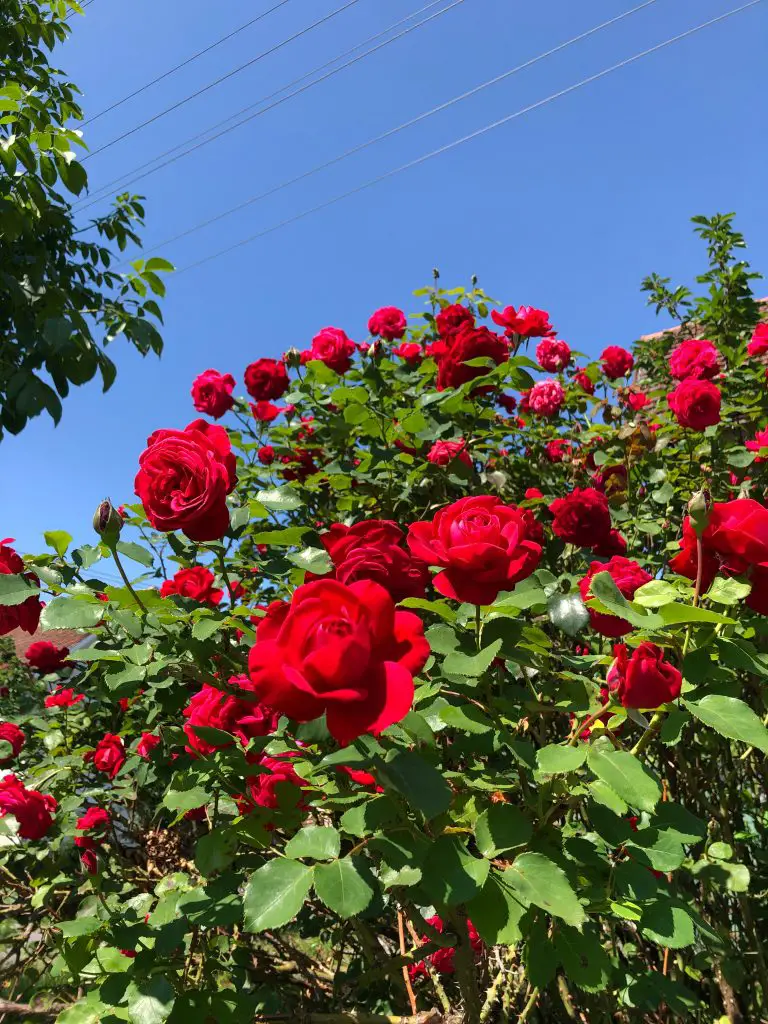Why Are My Roses Growing So Tall? How To Fix The Problem One of the most popular flowers to grow in the garden are roses. There are heaps of different varieties and colors that produce fantastic flowers that have a great scent, however, one of the more common questions that is asked is why roses grow so tall and get leggy.
The most common reason why roses get relatively tall in certain places is that they do not have sufficient access to light. The lack of access to light usually means that the plant will attempt to grow tall in order the access that light and often if the plant is growing relatively tall it usually does not flower as well as shorter roses due to the lack of light.
The lack of light available to the plants is usually caused by permanent structures or other plants within the garden. If the plants are in a location that is relatively shady the only fix to this problem is to transplant the rose to another location that is sunny. Roses ideally require a full sun location or an area that gets at least 6 to 8 hours of sun per day.
If it is necessary to transplant the rose the best time to do it is when the plant is dormant in winter. To get a good display in the first season after the plant is transplanted it is recommended that you move it at least 4 weeks prior to the plant producing new shoots.
The other cause of lack of light is usually other vegetation that is in the area. This can sometimes happen if there are several roses in close proximity to each other who are competing for sunlight. To avoid this problem the plants should ideally be placed at least 3 feet apart to ensure that they do not shade each other out.

How To Fix A Leggy Rose
Once the rose has become leggy it is relatively easy to fix however it is important to fix the underlying problem before reshaping the rose otherwise you will just have the same problem the following season.
The best time to fix a leggy rose is at the end of winter just before the plant is about to reshoot for the following season. This is also the time that most gardeners do the most significant maintenance on the rose in the year.
To fix the rose the first job is to remove any dead or diseased branches from the plant. However, in some cases, it is not always clear whether a branch is alive or dead on a rose. The easiest way to check this is to trim small sections from the top of the branch and inspect the interior of the branch. Most branches will have a moist yellow interior if they are alive.
Once the branches have been identified they should be cut all the way back to the base of the plant. The second step is to remove any branches that are crossing each other or even rubbing against each other. If the branches are crossing they will often produce wounds on the stems which will provide access points for disease.
The next step is to improve the plants’ overall access to light by pruning it in a way that maximizes the amount of light received. The most common way to do this is to create a goblet-like shape within the plant where any inward-facing branches are removed from the plant.
By removing the central branches you will improve not only the light available for the rest of the plants but also you will improve the airflow around the plant which reduces the chances of problems with fungal diseases such as black spot or powdery mildew.

Once these branches are removed the final step is to select what branches you are going to keep on the plants and which ones are you going to remove. Generally, I prefer to go for the thickest strongest branches that remain on the plant so if there are any that are relatively thin and spindly branches, less than a pencil’s thickness then they should be removed from the plant.
Once the unsuitable branches have been removed it is important to ensure that any remaining branches have a distance of at least 6 inches between each one of them to ensure that there is no overcrowding and shading out. This may require you to remove some perfectly healthy branches from the plant however it will help with the overall health of the plant.
The remaining branches should then be cut to a height of approximately 3 to 4 ft tall. In some cases this may mean that you are removing huge amounts of branches from the rose, however roses are extremely tough and they will tolerate very aggressive pruning, So this can be done without fear of killing the plant off.
In addition to pruning the plant, most gardeners will also take the opportunity to add fertilizer to the plant. The type of fertilizer does not have to be a rose-specific one you can also use general fertilizers like palletize manure and they will work just fine. Once the fertilizer is applied it is also a good idea to apply a new layer of mulch before watering the plant in well.
The mulch will help to suppress the weeds and also retain moisture during the warmer months to come. If you follow these simple directions you should have a rose that produces far more flowers in the following season.
I hope you found this article useful and have great success growing your rose plants at home if you have any additional comments or questions please leave them in the section below.
Relevant Articles
Is It Too Late To Sow Cosmos Seeds?
Baking Soda Vs Milk: Which Is Better For Controlling Powdery Mildew?
Do Ranunculus Spread? Are They Invasive?
Is Crocosmia Deer Resistant? What Can You Do To Protect The Plants?
